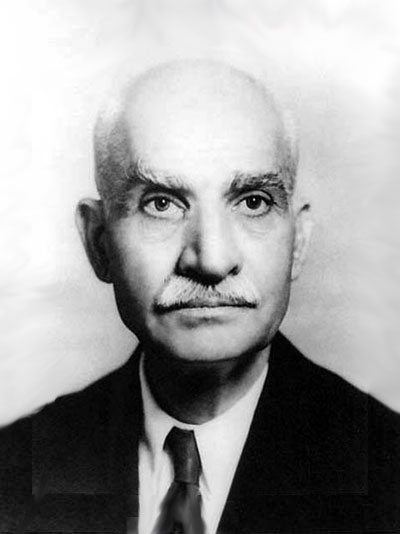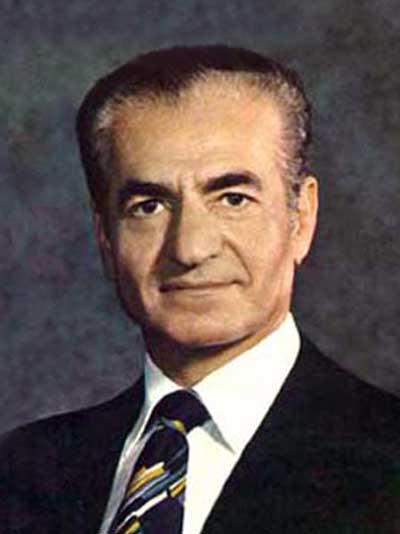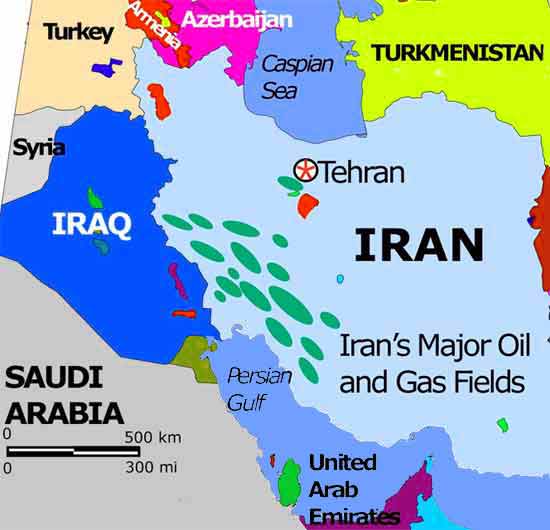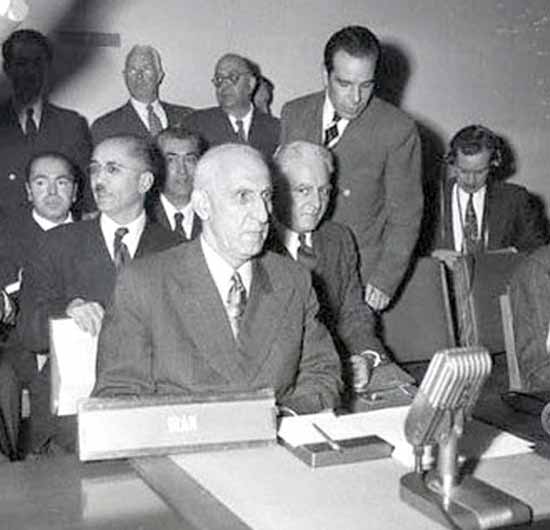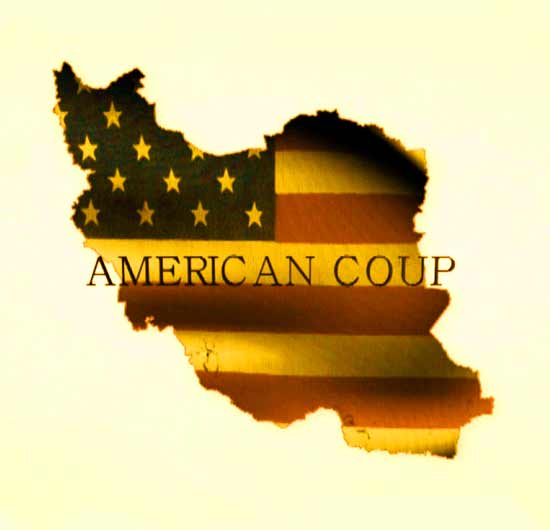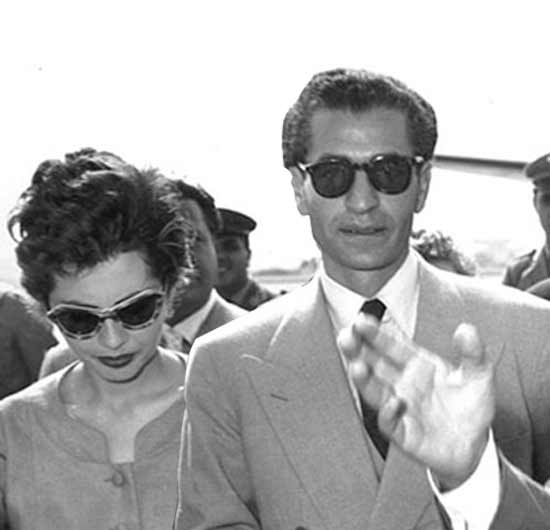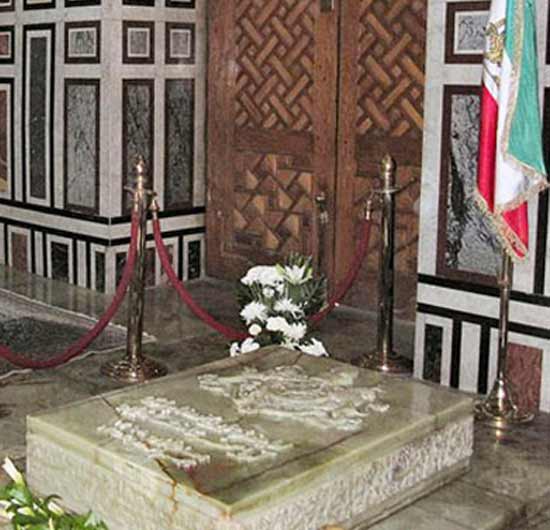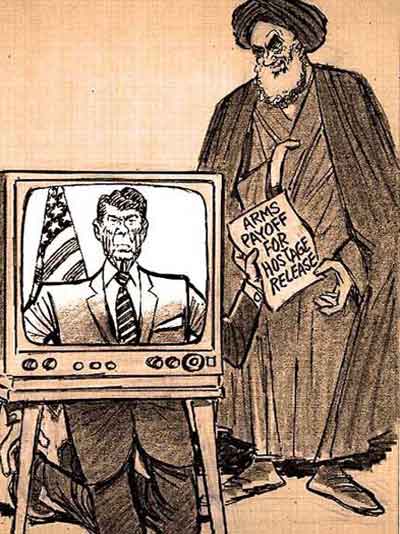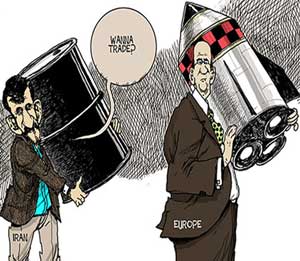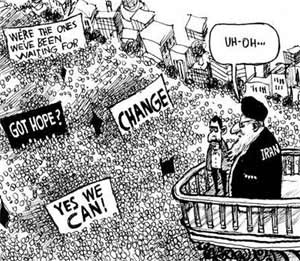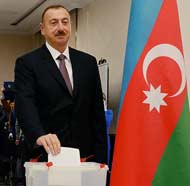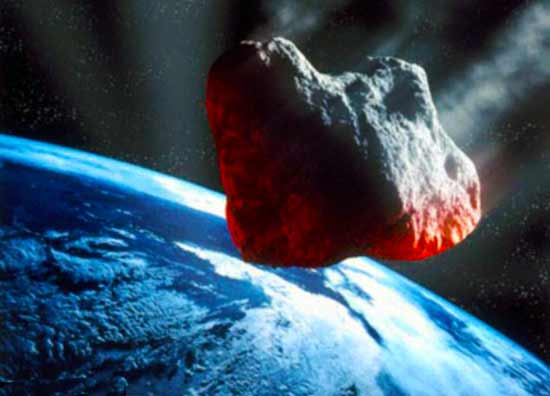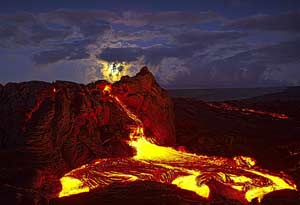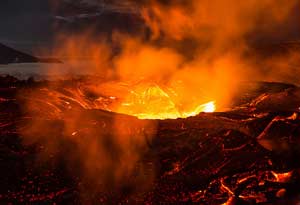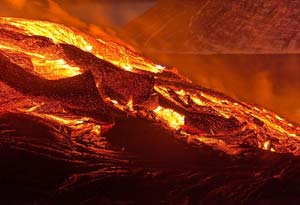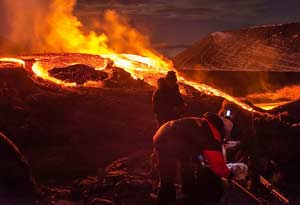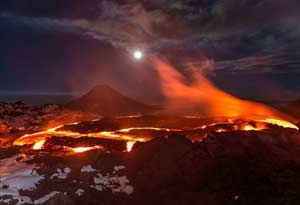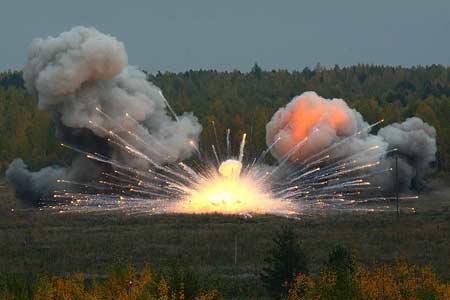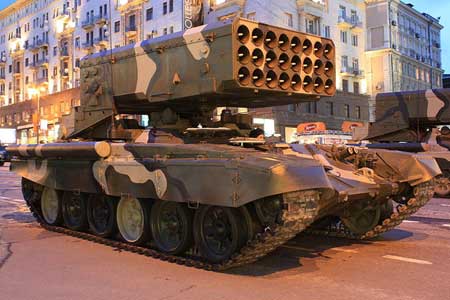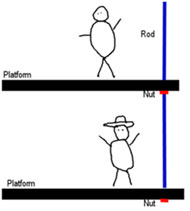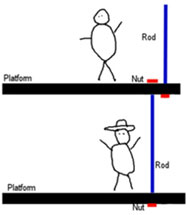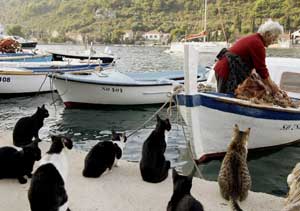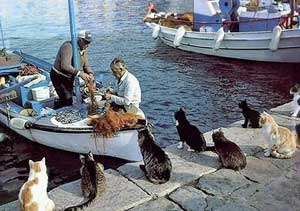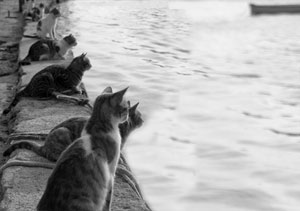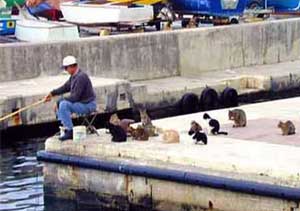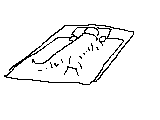Hypocrite: One who professes virtues he does not respect to secure the advantages of seeming to be what he despises.
—Truth Decay
Oct. 15, 2013
What’s the Big Deal with Iran?
Pity those who want to be good citizens, want to understand the world and their country’s role in it,
want to believe that their government seeks to do good. The more they learn, the more disappointed they’re doomed to become.
A dynasty is a sequence of rulers from the same family. In Iran, the Pahlavi dynasty, consisted of only two monarchs, father and son Reza Shah Pahlavi and Mohammad Reza Shah Pahlavi.
The Pahlavis came to power with the overthrow of Ahmad Shah Qajar, the last ruler of the Qajar dynasty. Ahmad Shah was pushed aside in a military coup in 1921 and went to live in France. But it wasn’t until 1925 that the National Assembly (like Parliament and known in Iran as the Majlis), formally deposed him and declared Reza Khan, a Brigadier General in the Persian Cossack Brigade, to be the new Shah. Reza had led the 1921 coup and had then become Commander-in-Chief of the Iranian Army. That 1921 coup d'état was partially assisted by the British government, which wished to halt the Bolsheviks’ penetration of Iran because of the threat it might pose to British possessions in India. The British had provided “ammunition, supplies and pay” for Reza’s troops. By 1925 Reza Khan (Khan means “chief”) was the new monarch of the Imperial State of Persia. The Constitutional Monarchy obliged Reza Shah (Shah is equivalent to “king”) to take his power from the Majlis; nevertheless, this king appears to have had a different idea about power.
Within 10 years, Reza Shah informed foreign embassies to call Persia by its ancient Persian name, Iran. He insisted that everyone think of themselves as “Iranian” first. He tried to break up tribes by having people move to different places. He tried to force the “blending” of heretofore compartmentalised groups he felt was needed to bring Iran into the modern world. He may have been right, but anyone who introduced that much stress into everyone’s lives was hardly likely to be popular. Several ethnic and social groups felt they were being suppressed.
In his favour, during his tenure, Reza Shah constructed roads, schools, and hospitals, opened a university, and built the Trans-Iranian Railway. He emancipated women (in 1936 he even banned the hijab), nationalised several economic sectors, and reduced the clergy’s power. But, since he apparently used repressive methods to achieve his results (against such strong opposition, could it have been otherwise?), his popularity waned. Was he categorically correct in his goals but perhaps wrong in his methods of implementation? Shouldn’t that be a problem best settled by the legislature?
Reza Shah despised the Brits and Soviets for constantly treating Iran as if it weren’t a sovereign state. Resentment built—Iran was a country larger than Britain, Germany and France combined and the country’s oil wealth was disproportionately benefitting Britain. But after the Brits and Soviets invaded, the Shah’s generals betrayed him and his army deserted him. (No doubt money changed hands here and there, or threats.) Reza Shah, who had alienated too many people at last, was forced to abdicate in 1941 in favour of his son, Mohammed Reza Shah Pahlavi who, thanks to his more cooperative attitude toward the invaders, became king much sooner than he normally would’ve. He was unprepared; he also proved himself to be self-indulgent and unpopular.
Mohammad Rezā Shāh Pahlavī was the Shah from 1941 until his overthrow by the Iranian Revolution on 11 February 1979. He was the second and last monarch from the House of Pahlavi. He gave himself several titles, including “Shahanshah” (King of Kings), “Aryamehr” (Light of the Aryans) and “Bozorg Arteshdārān” (Head of the Warriors). (As you can see, he was a very modest man.) As ruler, he introduced what he dubbed the White Revolution, a series of economic, social and political reforms intended to transform Iran into a global power and modernise the nation. How? By nationalising certain industries and by granting women suffrage. He seems to have had views similar to his father, but would presumably be have been seen as more moderate.
A secular Muslim himself, Mohammed Reza gradually lost support from the Shi’a clergy of Iran (as well as the working class) due to his mandatory policies of modernisation and secularization, his recognition of Israel, and because of corruption issues that surrounded him, his family, and the ruling elite. Annoying the clergy may have been the final straw. Various controversial policies were enacted, including banning the communist Tudeh Party, and suppressing political dissent via a new intelligence agency, the SAVAK (created with the help of the United States’ Central Intelligence Agency, the CIA), certainly the source of some of the Shah’s more radical ideas—and perhaps the impetus for his lavish lifestyle as well.
During Mohammed Reza’s reign, Iran marked the anniversary of 2,500 years of continuous monarchy since the founding of the Persian Empire by Cyrus the Great. The celebration, to which many heads of state around the world were invited, was an ultra-lavish affair.
Several factors contributed to his strong opposition, most notably that there was such strong US and UK support for his regime and that he frequently clashed with Islamists. By 1979, widespread political unrest transformed into revolution. True to his character, the Shah turned and ran. The Iranian monarchy was formally abolished and Iran was declared an Islamic republic led by the Ayatollah Khomeini. Facing likely execution should he return to Iran, Mohammed Reza died in exile in Egypt (where President Anwar Sadat had granted him asylum).
Dr Mohammad Mosaddegh was an Iranian politician and nationalist leader during this period. Mosaddegh had earned a Masters in International Relations from the University of Paris (Sorbonne) and a Doctorate in Law from the University of Neuchâtel in Switzerland; in 1920, when he was 38, Mosaddegh was invited by the new Iranian Prime Minister to become the Minister of Justice but on his way to Tehran, he stopped off in Shiraz, where the people apparently asked him to become their Governor for the Fars Province. He decided to do that instead. He was appointed Finance Minister in 1921 and then Foreign Minister in June 1923. He became Governor of the Azerbaijan Province that same year and was also re-elected to the Majlis. Mosaddegh was apparently a busy and capable man.
In 1925, when supporters of Reza Khan first proposed legislation to dissolve the Qajar dynasty and appoint Reza Khan the new Shah, Mosaddegh voted against this, arguing that such an act was a subversion of the Iranian constitution. He praised Reza Khan’s achievements as a statesman, but encouraged him to respect the constitution and become Prime Minister, not Shah. Nevertheless, on 12 December 1925, when the Majlis formally deposed the young Ahmad Shah Qajar, they declared Reza Shah the new monarch. Live by the sword, die by the sword—in 1941, Reza Shah would be forced by the British to abdicate in favour of his more passive son, Mohammed Reza Pahlavi.
At the age of 52 (in 1944), Mosaddegh helped found the National Front of Iran, aimed at establishing democracy and ending foreign influence in politics.
General Haj-Ali Razmara, the Shah’s choice of Prime Minister, was approved in June 1950. On 3 March 1951 he appeared before the Majlis in an attempt to persuade the deputies against “full nationalization on the grounds that Iran could not override its international obligations and lacked the capacity to run the oil industry on its own.” Though he had spoken the truth, it proved to be his big mistake. In 1951, the Majlis named Mosaddegh Prime Minister instead. Mohammed Reza, recognising Mosaddegh’s popularity, approved the appointment (he was ever the go-along-to-get-along sort).
Most of Iran’s known oil reserves were in the Persian Gulf area. These had been developed by the British Anglo-Iranian Oil Company (AIOC) for export to Britain. For a number of reasons—a growing consciousness of how little Iran was getting from the AIOC for its oil, the refusal of the AIOC to offer a 50%–50% profit sharing deal to Iran (as Aramco had recently done to Saudi Arabia), mounting anger over Iran’s defeat and occupation by the Allied powers during the war with no offer to cover damage done—the nationalization of Iran’s oil had come to be seen by almost everyone as a big deal, a matter of pride as well as economics. Britain was pocketing money Iran felt they should be sharing. Thinking Iran had no choice but to continue with the same arrangement, the AIOC airily brushed their complaints off. Since early in the 20th century, they’d had a lock on the production and sale of Iranian oil. No need for any changes.
Mosaddegh felt he had no choice but to nationalise oil production in Iran so that Iranians could finally benefit more fully from their own resources. He offered compensation, but the Brits snorted—that’s wildly inadequate, they said. “Persian oil,” intoned Britain’s foreign secretary, “is of vital importance to our economy.” One British diplomat scoffed at the very idea and said, “We English have had hundreds of years of experience on how to treat the natives.” So Mosaddegh closed the British embassy and forced all British agents out of the country. The Brits turned to the US for help.
After negotiations for higher oil royalties failed, the Iranian Majlis and Senate voted to nationalize the British-owned-and-operated AIOC, taking control of Iran’s oil industry. Since the Majlis had named Mosaddegh as the new Prime Minister by a vote of 79–12, this made the Shah aware of Mosaddegh’s rising popularity and political power, so he backed down and officially appointed Mosaddegh to the Premiership. Mosaddegh promptly nationalised the AIOC, cancelling its oil concession and expropriating its assets.
Following Mosaddegh’s successful nationalisation of the British-owned Anglo-Iranian Oil Company,
Mohammed Reza Shah Pahlavi was virtually forced to appoint him premier (1951).
The confrontation between Iran and Britain escalated as Mosaddegh’s government refused to allow the British any involvement in Iran’s oil industry so Britain made sure Iran could sell no oil. Mosaddegh broke off negotiations with the AIOC after he was told that they were going to pull out their employees and tell owners of oil tanker ships that “receipts from the Iranian government will not be accepted on the world market.” Within two months, the AIOC evacuated technicians and closed down facilities. Refineries could no longer produce. The British government announced a blockade and reinforced naval presence in the Persian Gulf. Complaints against Iran were lodged before the United Nations Security Council (who politely declined to take any action). Britain threatened legal action against purchasers of any oil produced in the British-owned refineries; international oil companies agreed not to interfere. The entire Iranian oil industry came to a virtual standstill. This put a severe strain on the implementation of Mosaddegh’s promised domestic reforms. BP and Aramco doubled their production in Saudi Arabia, Kuwait and Iraq, to make up for production lost in Iran: no hardship was being felt in Britain.
Mosaddegh was still very popular. To Mohammed Reza, he insisted on the constitutional prerogative of the Prime Minister to name the Minister of War and Chief of Staff, something the Shah had traditionally been doing. The Shah refused so Mosaddegh immediately announced his resignation appealing directly to the public for support. He pronounced that “in the present situation, the struggle started by the Iranian people cannot be brought to a victorious conclusion.”
Fine. Mohammed Reza appointed a veteran politician as Iran’s new Prime Minister. On the day of his appointment, the new Prime Minister announced his intention to resume negotiations with the British to end the oil dispute, a complete reversal of Mosaddegh’s policy. Strikes broke out in all of Iran’s major towns, with the Bazaar being forced to close down in Tehran. Hundreds of demonstrators were killed or suffered serious injuries. After 5 days of these mass demonstrations, military commanders ordered their troops back to the barracks, fearful of overstraining the enlisted men’s loyalty. This left Tehran in the hands of the protesters. Frightened by the unrest, the Shah dismissed his newly-appointed Prime Minister and re-appointed Mosaddegh, granting him the full control of the military he had previously demanded.
More popular than ever, a greatly strengthened Mosaddegh convinced the Majlis to grant him emergency powers. With these, he limited the monarchy’s unconstitutional powers, cut the Shah’s personal budget, forbade him to communicate directly with foreign diplomats, transferred royal lands back to the state, and expelled the Shah’s politically active twin sister, Ashraf Pahlavi. He decreed a land reform law that established village councils and increased the peasants’ share of production. This weakened the landed aristocracy, abolishing Iran’s centuries-old feudal agriculture sector, replacing it with a system of collective farming and government land ownership.
Unfortunately, Iranians were steadily becoming poorer and unhappier due to the British boycott over oil nationalisation. Mosaddegh’s fiery style and unorthodox methods made him many enemies and on several occasions ran him afoul of Iran’s constitution. He acted in a unilateral manner when he felt it was necessary to get the job done, including taking power from the Majlis. Whatever Mosaddegh wanted, he got. Jealousies eventually caused his political coalition to fray. The clergy was an especially formidable opponent. Due mostly to British infiltrators, several former members of his coalition turned against him. The government of the United Kingdom was growing increasingly distressed over Mosaddegh’s policies and was especially bitter at losing control of the Iranian oil industry. Repeated attempts to reach a settlement failed. Unable to resolve the issue, Britain had turned to the US for help. But American Secretary of State Dean Acheson concluded that the British were destructive and determined on a rule-or-ruin policy in Iran. The US declined to get involved in the dispute (perhaps hoping to forge a successful partnership themselves).
Iran was terribly mismanaged by successive politicians; possibly none more so than Mosaddegh himself, who overplayed his hand at every turn, misread situations, and exploited public opinion to ensure that he could implement doomed policies without check. For example, he demanded to appoint his own Minister of War, resigned when his request was refused, then appealed to the mob to get back into power. All this, but to what end? Why did Mosaddegh want control of the military? Could he have been naïve enough to think Iran could fight the entire world, or did he not care, valuing his own short-term plans over the good of the country? Two powerful, autocratic men were both striving to become effective dictators, both with very different visions for Iran. Sadly, the one with the least realistic vision won, to Iran’s continuing detriment.
Harry Truman was America’s President when he hosted Iran’s Prime Minister, Dr Mohammad Mosaddegh, at the White House. This photograph was taken on October 23, 1951. Truman didn’t approve of any US involvement with “regime change” in Iran. The issue was under discussion because Dr Mosaddegh wanted to nationalize Iranian oil, thereby removing it from control by the Anglo-Iranian Company. This upset Britain, who insisted that the US was undermining their campaign to isolate Iran.
In October 1952, Mosaddegh declared Britain an enemy, and severed all diplomatic relations. British intelligence officials suggested to American intelligence that the Prime Minister could be/should be ousted. But President Truman had contempt for old-style imperialists and didn’t even bother to respond. Unfortunately for Mosaddegh, a Republican, Dwight Eisenhower, became the US president in 1953. The British (ostensibly) convinced Eisenhower that Mosaddegh was close to being a communist, and everyone knew that fighting communism was a moral crusade for Eisenhower’s Secretary of State, John Foster Dulles (whose brother, Allen, just happened to be the new head of the CIA). The US administration under Dwight D Eisenhower and the British government under Winston Churchill, thought they could make a good enough case, so they agreed to work together toward Mosaddegh’s removal. Classified documents show British intelligence officials played a pivotal role in initiating and planning the coup, and that Washington and London shared an interest in maintaining control over Iranian oil. In March 1953, Secretary of State John Foster Dulles directed the US Central Intelligence Agency (CIA), headed by younger brother Allen, to draft plans to overthrow Mosaddegh.
Actually Mosaddegh disliked communist doctrine. He had excluded them completely from his government, though as a believer in democracy, he allowed Iran’s Communist Party, the Tudeh, to remain. During his time as Prime Minister, a wide range of progressive social reforms were carried out. Unemployment compensation was introduced, factory owners were ordered to pay benefits to sick and injured workers, and peasants were freed from forced labour on their landlords’ estates; 20% of the money landlords received in rent was placed in a fund to pay for development projects such as public baths, rural housing, and pest control.
The Dulleses saw the overthrow of Mosaddegh as a “rollback” of communism (or loudly said they did). On 4 April 1953, CIA director Dulles approved US$1 million to be used “in any way that would bring about the fall of Mosaddegh.” The CIA’s Tehran station launched a propaganda campaign against him. According to the New York Times, in early June, American and British intelligence officials met again, this time in Beirut, to put the finishing touches on their strategy, resulting in the chief of the CIA’s Near East and Africa division, Kermit Roosevelt, Jr (grandson of former US President Teddy Roosevelt) arriving in Tehran to oversee things. The plot, known as Operation Ajax, centred on convincing Iran’s monarch to issue a decree to dismiss Mosaddegh from office. This strategy was meant to give the impression of legitimacy to the secret coup. The Shah was terrified to attempt such a dangerously unpopular and legally questionable move but (as always) succumbed under pressure, formally dismissing Mosaddegh in a written decree and nominating the CIA’s choice, General Fazlollah Zahedi, as Prime Minister. Then he flew to Baghdad and from there hid safely (he hoped) in Rome, Italy.
Iranian CIA operatives pretending to be socialists and nationalists threatened Muslim leaders with savage punishment if they opposed Mosaddegh, thereby giving the impression that Mosaddegh was cracking down on dissent. This heightened sentiment against him within the religious community. Massive protests engineered by Roosevelt’s team took place across the city and elsewhere (with hungry tribesmen paid to participate). Fake anti- and pro-monarchy protesters violently clashed in the streets, looting and burning mosques and newspapers, leaving many dead. The pro-monarchy leadership that had been chosen and hidden by the CIA team was unleashed at just the right moment. Mosaddegh was rounded up, tried for high treason by the Shah’s military court, found guilty, imprisoned for 3 years in solitary confinement in a military jail, then kept under house arrest for the rest of his life (he died a prisoner in 1967). Mosaddegh supporters were rounded up and imprisoned, tortured, and/or executed. The minister of Foreign Affairs, Dr Hossein Fatemi (Mosaddegh’s closest associate), was executed by firing squad.
Historians disagree on what motivated the United States to change its policy towards Iran and stage the coup. (A change in administrations, perhaps? A realist would say that elections don’t—or shouldn’t—materially change foreign policy. After all, if the US were acting in its own selfish interests, and a realist believes this is both inevitable and maybe even moral besides, then it would act the same under Eisenhower as it did under Truman because US interests—at least as they pertain to oil, the Middle East, and Anglo-American relations—had not changed. The only way a change in administrations would be expected to have a big impact is if the people involved were not realists, but idealists—for example, if the Dulles brothers truly were believers in the fight against communism, or if Truman truly was disgusted with imperialists.)
One Middle East historian identified the coup d'état as “a classic case of nationalism clashing with imperialism in the Third World.” Secretary of State Dean Acheson admitted that the 'Communist threat’ charge was nothing more than a smokescreen, a rhetorical device rather than a real issue. (Can we not just say “a lie”?) Iran’s oil was always the central focus of the coup, for both the British and the Americans, though “much of the discourse at the time linked it to the Cold War” which seemed to be a more honourable excuse. If Mosaddegh had succeeded in nationalizing the British oil industry in Iran, that would have set a bad example and may have been a threat to US oil interests throughout the world because other countries may have tried to do the same. Mosaddegh didn’t want any compromise solutions that allowed foreign control—he wanted real nationalization, both in theory and practice.
But Zahedi’s new government soon reached an agreement with foreign oil companies to form a consortium and “restore the flow of Iranian oil to world markets in substantial quantities” giving the US and Great Britain the lion’s share. (Surprise!) In return, the US massively funded the Shah’s government, including his army and secret police force. They protected this petulant narcissist until he was overthrown in 1979. The part played by the US in the overthrow of Mosaddegh served as a rallying point in anti-US protests during the 1979 Iranian Revolution. Mosaddegh is even today one of the most popular figures in Iranian history. In 2004, the Egyptian government changed a street name in Cairo from Pahlavi to Mosaddegh, hoping to improve Iranian relations.
To many around the world, US actions further solidified sentiments that the West was a meddlesome influence in Iranian politics. In the year 2000, reflecting on this notion, US Secretary of State Madeleine K Albright stated: “In 1953 the United States played a significant role in orchestrating the overthrow of Iran’s popular Prime Minister, Mohammed Mosaddegh. The Eisenhower Administration believed its actions were justified for strategic reasons; but the coup was clearly a setback for Iran’s political development. And it is easy to see now why many Iranians continue to resent this intervention by America in their internal affairs.”
No kidding.
“The Shah requires special preparation—by nature a creature of indecision, beset by formless doubts and fears, he must be induced to play his role…” — TP Ajax Plan
Mohammed Reza Shah returned to power in 1953, but never extended the elite status of the court to the technocrats and intellectuals who emerged from Iranian and Western universities. Indeed, his system irritated the new classes, for they were barred from partaking in any real power. With Iran’s great oil wealth, Mohammed Reza Shah became the pre-eminent leader of the Middle East, and self-styled guardian of the Persian Gulf. In 1961, he defended his autocratic rule, saying, “When Iranians learn to behave like Swedes, I will behave like the King of Sweden.” By 1975, he abolished the multi-party system of government so that he could rule through a one-party state under the Rastakhiz (Resurrection) Party in his inimitable autocratic fashion. All Iranians were pressured to join in. The Shah’s own words on its justification was; “We must straighten out Iranians’ ranks. To do so, we divide them into two categories: those who believe in the monarchy, the constitution, and the White Revolution and those who don’t. A person who does not enter the new political party and does not believe in the three cardinal principles will have only two choices. He is either an individual who belongs to an illegal organisation, or he is a traitor. Such an individual belongs in an Iranian prison, or if he desires, he can leave the country tomorrow without even paying exit fees; he can go anywhere he likes, because he is not Iranian, he has no nation, and his activities are illegal and punishable according to the law.” All Iranian citizens and the few remaining political parties were to become part of Rastakhiz.
In 1978, the deepening opposition to the Shah erupted in widespread demonstrations and rioting. Recognising that military violence against the demonstrators was failing to crush the rebellion, the Shah abdicated and departed Iran mid-January 1979. Despite decades of pervasive surveillance by SAVAK working closely with CIA, the extent of public opposition to the Shah and his subsequent sudden departure came as a considerable surprise to the US intelligence community and national leadership. As late as September 1978 the US Defense Intelligence Agency reported that the Shah “is expected to remain actively in power over the next 10 years.” Explanations for why the Shah was overthrown include that he was beholden to—if not a puppet of—a non-Muslim Western power (the United States) whose foreign culture was too-heavily influencing Iran. Additional contributing factors included perceptions of oppression, brutality, corruption, and extravagance and the fact that some achievements of the Shah—such as broadened education—had had unintended consequences. While school attendance rose, Iran’s labour market couldn’t absorb that many educated youth. In 1966, high school graduates had a higher rate of unemployment than did the illiterate; therefore, the educated unemployed generally supported the revolution.
During his second exile, the Shah travelled from country to country seeking what he hoped would be temporary residence. He was found to be suffering from stones in his gallbladder that required prompt surgery. He was offered treatment in Switzerland but insisted on treatment in the US. At the request of David Rockefeller, President Jimmy Carter reluctantly allowed the Shah into the country to undergo surgical treatment at the New York Weill Cornell Medical Hospital. The Shah was taken later by US Air Force jet to Kelly Air Force Base in Texas and from there to Lackland Air Force Base. It was anticipated that his stay would be short; however, surgical complications ensued which required six weeks of hospitalisation. This prolonged stay in the US was extremely unpopular with the revolutionary movement in Iran, which still resented them for the overthrow of Prime Minister Mosaddegh and their years of controlling support for the Shah’s rule. The Iranian government demanded he be extradited to Iran but was told he needed to remain hospitalised. This resulted in the storming of the US embassy in Tehran, and the kidnapping of American diplomats, military personnel and intelligence officers, which soon became known as the Iran Hostage Crisis.
The Shah died in 1980 (at the age of 60) while in exile in Egypt. He was given a state funeral by Egyptian President Anwar Sadat and buried in Cairo alongside King Farouk of Egypt, his former brother-in-law (the Shah had been married to Farouk’s sister, but they were divorced after about 6 years). He was forced to divorce his next wife, Soraya, after 7 years when it was discovered that she couldn’t have children. He would have preferred to stay married.
After the hostage crisis began, the United States froze Iranian assets held in the US, a decision of US President Jimmy Carter. This sent the two countries into a long-term period of hostilities. Anti-American sentiments in Iran were fuelled by close ties between the US and the unpopular Mohammed Reza Shah. The crisis contributed to Carter’s failure to win re-election. Circumstances regarding the release of the hostages became known as the “Iran-Contra Affair” when it was discovered that the Reagan administration had sold arms to Iran during an arms embargo in exchange for the release of the 52 American hostages. They then used the money from arms sales to fund the Nicaraguan Contras (though under the Boland Amendment further funding of the Contras was prohibited by Congress).
Barbara Honegger, former white house policy analyst for President Reagan, has since stated, “The most important thing to come out of the hearings is what didn’t even get asked, and that was that Ronald Reagan cut a deal with Iran before the 1980 election to send arms to Iran in exchange for Iran’s agreeing to delay the release of our 52 hostages.” Honegger was a dedicated member of the Reagan-Bush Presidential campaign in 1980; she worked on the research and policy staff and later was a White House policy analyst. She said, “The campaign was afraid that Jimmy Carter would successfully bring the 52 hostages home, what we called the October surprise, and win the election.” George H Bush (then the vice-presidential candidate), Richard Allen (who became Reagan’s first national security advisor), and Donald Gregg (who later became one of Bush’s national security advisers) are said to have passed millions of dollars to the Iranians to delay the release of the 52 American hostages an additional 76 days. They met with an emissary of the Khomeini regime who offered to delay if they would supply the Iranians with arms for their war against Iraq, once Reagan became the US President. The Americans supplied Iran with arms and Iran delayed releasing the hostages.
The National Security Archive released documents detailing British attempts to block American disclosure of intervention in Iran back in 1978. At the time, Britain’s Foreign Office feared that a planned State Department publication would undermine the UK’s current standing in Iran. The National Security Archive responded by asking if current British meddling was behind the stalled declassification of even more key documents. The British government’s apparent inability to acknowledge what the world already knows may be difficult for outsiders to understand. It becomes positively baffling when senior public figures fully aware of the history have already acknowledged London’s role. In 2009, former Foreign Secretary Jack Straw publicly remarked on Britain’s part in toppling Mosaddegh, which he categorised as one of many outside “interferences” in Iranian affairs in the last century. Yet, present indications are that the UK government is not prepared to release either its own files or evidently to approve the opening of American records that might help bring some degree of closure. While the National Security Archive applauds the CIA’s decision to make some materials available, it can be clearly seen that the material could’ve safely been declassified years ago with no risk to national security. Keeping too many things secret doesn’t make for a happy citizenry over time.
Iran Air Flight 655 flies from Tehran, Iran, to Dubai, United Arab Emirates, via Bandar Abbas, Iran. On 3 July 1988, at the end of the Iran–Iraq War, this flight, an Airbus A300, was shot down by a surface-to-air missile fired by the United States Navy guided missile cruiser USS Vincennes. The plane was a regularly-scheduled flight on its regularly-scheduled route over the Strait of Hormuz, flying in Iranian airspace over Iran’s territorial waters in the Persian Gulf. It was destroyed and all 290 on board, including 66 children and 16 crew, perished. The Vincennes had entered Iranian territorial waters after one of its helicopters drew warning fire from Iranian speedboats operating within Iranian territorial limits. According to the US government, the crew incorrectly identified the plane as an attacking F-14 Tomcat fighter. Contributing to the error was the fact that the airliner didn’t respond to several inquiries to change course and didn’t identify itself clearly as civilian. This was supposedly because Vincennes was signalling warnings on a military channel and the civilian plane didn’t receive it. The event generated a great deal of controversy and criticism of the US. Some analysts blamed US military commanders and the captain of Vincennes for reckless and aggressive behaviour in a tense and dangerous environment. In 1996, the US and Iran reached “an agreement in full and final settlement of all disputes, differences, claims, counterclaims” relating to the incident at the International Court of Justice. As part of the settlement, the US agreed to pay US$61.8 million, an average of $213,103.45 per passenger, in compensation to the families of the Iranian victims. They also paid for the cost of the plane. However, they never admitted responsibility, nor apologised to Iran. The incident overshadowed Iran-US relations—just one more example of American arrogance. Following the explosion of Pan Am Flight 103 six months later, the British and American governments initially blamed a Palestinian militant group backed by Syria, assuming that Iran had assisted them in retaliation for Iran Air Flight 655. (Once again, the US was completely wrong—Libya’s Gaddafi accepted responsibility for the Lockerbie bombing—with no help from Iran—and paid compensation to the families of the victims.)
As CIA covert action roars back in places like Pakistan, Afghanistan, and Yemen, a detailed, public examination of such major past operations would provide both citizens and policymakers with needed perspective and caution. There is concern, however, that the Iran volume will never emerge due to CIA resistance and the fear that publishing the truth would fuel the propaganda machine of a hostile Iranian regime.
From Military Critique / TP Ajax: Lessons Learned Regarding Military Planning Aspects of Coup d’etat as published in CIA Internal Histories:
Information gathering can sometimes be of use during occasions in which it is necessary to fabricate “excuses for action.” In attempting to recruit personnel to your cause, it will always be necessary to provoke them to action when their motivation is insufficient to cause them to act under their own steam.
You may need the occasional bit of blackmail?
Think for a second of how Iran has been treated by the West over the past century. And it’s still happening. The “sins” of Iran? The major ones are that they have oil and that they’re all that stands between Russia and the Persian Gulf. Meanwhile, the US and Britain act like schoolyard bullies. The British embassy in Tehran was closed in late 2011 after a mob overran the building as tensions over a possible attack on Iran’s nuclear facilities ran high. Iran also closed its embassy in London. Relations have remained tense since then, but the recent election of Iranian President Hassan Rouhani has raised hopes of a thaw between Iran and the West. British Foreign Secretary William Hague has said that his country is taking steps toward reopening its embassy in Tehran, agreeing to an exchange of diplomats to discuss improving relations. (Just don’t expect any apologies.)
Social distance makes it easier to focus on small differences between groups and to put a negative spin on the ways of others and a positive spin on our own ways. Freud calls this “the narcissism of minor differences.” In contrast, extensive interpersonal contact counteracts biases by letting people from hostile groups get to know one another as individuals and even friends. (Hire an Iranian. Invite one to your next party.)
Blowback means unintended consequences from a covert operation that are suffered by the aggressor. To the suffering civilians of the aggressor nation, the effect typically manifests itself as “random” acts of political violence without a discernible, direct cause. The uninformed public—in whose name the intelligence agency acted—are unaware of the secret attacks that provoked this revenge, this counterattack, against them.
Lying is a misrepresentation of the truth, but Bullshit is a misrepresentation of the self. A bullshitter has an indifference to truth, a trait worse than lying. Bullshit not only is deceptive, it contributes to decay in public discourse (increasing meaninglessness). It directs attention to the trivial as well as the false. More seriously, it results in a decline of public intelligence. No one should want that. The only rule the bullshitter follows is to say anything so long as it works (in other words, ends justify means).
Clear thinking depends on focused attention + clear expression, not on emotional calls to action. Governments that ensure that most of what they do is kept secret and also that rely on emotional calls to action (my guess is that this group includes every country that thinks they can pull it off successfully) have become bullshit nations because they’ve come to accept that it’s okay to use whatever means are necessary to reach their desired ends. But sometimes that particular snake will come back to bite them.
I am an Iranian civilian … Many people here, like me, grew up in wartime between Iran and Iraq. It finished more than 20 years ago, but I still can hear the sound of bombs, I still can recall the pictures of my dead countrymen. I can still hear the red-alarm sound. In a word, we hate war and we don’t want to experience that again. When you are talking about Iran’s nuclear programme, you assume we’re going to make nuclear weapons and then attack somewhere (say Israel). But what benefits derive from that? Even if Iran reached that level of technology, it wouldn’t threaten other countries; it’s just a political game. It would be a message to some countries, who always wish to attack and destroy Iran (say Israel). You could never ever find one person here who accepts an attack on another country (even Israel), but all of us will defend our country. War with Iran probably won’t last for years, it would be short, yet severe. And what do you think we will get? Many dead people, both civilians and troops; what we will feel after that?
Hopeless, depressed, lost in our past memories and future never-come dreams...
Sources:
http://en.wikipedia.org/wiki/1953_Iranian_coup_d%27%C3%A9tat 1953 Iranian coup d'état from Wikipedia.
http://en.wikipedia.org/wiki/Blowback_%28intelligence%29 Blowback (intelligence) from Wikipedia.
http://papers.ssrn.com/sol3/papers.cfm?abstract_id=2301256 “Bullshit, Politics, and the Democratic Power of Satire“ by Paul Babbitt, Southern Arkansas University, 2013.
http://www.aljazeerah.info/News/2013/August/21%20n/CIA%20Admits%20Role%20in%20Iranian%20Coup%20of%201953,%20Overthrowing%20Mosaddegh%20Government.htm “CIA Admits Role in Iranian Coup of 1953, Overthrowing Mosaddegh Government” by Joseph Bamat, France 24, 20 August 2013.
http://www2.gwu.edu/~nsarchiv/NSAEBB/NSAEBB435/ “CIA Confirms Role in 1953 Iran Coup” edited by Malcolm Byrne, The National Security Archive, 19 August 2013.
http://www.opsecnews.com/cover-up-behind-the-iran-contra-affair-2/ “Cover Up: Behind the Iran-Contra Affair” by Abrams Hap, Opsec News, 5 March 2013.
http://www.macrohistory.com/h2/ch24t3.htm “Intervention in Iran“ from Macrohistory and World Timeline.
http://en.wikipedia.org/wiki/Iran_Air_Flight_655 Iran Air Flight 655 from Wikipedia.
http://www.brookings.edu/blogs/iran-at-saban/posts/2013/08/22-iran-press-report-mosaddegh “Iran Press Report: The Coup against Mosaddegh, 60 Years After” by Mehrun Etebari, Brookings, 22 August 2013.
http://en.wikipedia.org/wiki/Mohammad_Mosaddegh Mohammad Mosaddegh from Wikipedia.
http://www.mohammadmossadegh.com/biography/ “Dr Mohammad Mosaddegh Biography“, The Mosaddegh Project.
http://en.wikipedia.org/wiki/Mohammad_Reza_Pahlavi Mohammad Reza Pahlavi from Wikipedia.
http://www.fouman.com/Y/Farsi4-Mohammad%20Reza%20Shah “Mohammad Reza Shah“ from the Collective Iranian Culturebase.
http://www.fouman.com/Y/English_Persian_History_Glossary-Mosaddegh.htm “Mosaddegh“ from the Collective Iranian Culturebase.
http://www.opsecnews.com/operation-tp-ajax/ “Operation TP-AJAX“ posted by Abrams Hap. Opsec News, 18 April 2013.
http://en.wikipedia.org/wiki/Pahlavi_dynasty Pahlavi Dynasty from Wikipedia.
http://en.wikipedia.org/wiki/Rez%C4%81_Sh%C4%81h Rezā Shāh from Wikipedia.
http://en.wikipedia.org/wiki/SAVAK SAVAK from Wikipedia.
http://www2.gwu.edu/~nsarchiv/NSAEBB/NSAEBB28/ “The Secret CIA History of the Iran Coup, 1953” edited by Malcolm Byrne, The National Security Archive, 29 November 2000.
http://www.fouman.com/Y/Get_Iranian_History_Today.php?artid=9 “US Reacts to Hostage Crisis” by Mir M Hosseini, 13 November 1979, Iranian History.
http://williamblum.org/aer/read/121 “The Anti-Empire Report #121” by William Blum, 7 October 2013.
http://www.csmonitor.com/Commentary/Opinion/2011/0325/Why-is-US-withholding-old-documents-on-covert-ops-in-Congo-Iran “Why Is US Withholding Old Documents on Covert Ops in Congo, Iran?” by Stephen R Weissman, The Christian Science Monitor, 25 March 2011.
A country is not just what it does but also what it tolerates … If I sit silently, I have sinned.
— Mohammad Mosaddegh
| Azerbaijan’s recent big presidential election was anticipated to be neither free nor fair. President Ilham Aliyev, who took over from his father 10 years ago, has stepped up intimidation of activists and journalists. Rights groups are complaining about free speech restrictions and one-sided state media coverage. The BBC’s headline for its story on the election read “The Pre-Determined President.” So expectations were pretty low. Even still, one expects a certain ritual in these sorts of authoritarian elections, so it was a bit awkward when Azerbaijan’s election authorities released vote results — a full day before voting had even started. Pushed out on an official smartphone app run by the Central Election Commission, results showed Aliyev winning by a landslide with 72.76% of the vote. That’s on track with his official vote counts in previous elections: he won (“won”?) 76.84% of the vote in 2003 and 87% in 2008. |
||
Mutual Entertainment Society
Bonnie Anna (also known as Miss Chief) does random tumbling and gets a surprise fan.
FunDipped Productions is an Orlando-based circus theatre company devoted to education and entertainment.
- Intelligent Technology: A network of computers could develop a mind. Machines could direct resources toward their own goals at the expense of human needs, thus threatening mankind.
- Cyber Attacks: Power grids, air traffic control, banking, and communications absolutely rely on interconnected computer systems. If these networks collapse due to action by enemy nations or terrorists, the resultant paralysis could cause a breakdown in society.
- Engineered Infection: A man-made supervirus or superbacteria with no antidote could escape from a lab or could be deliberately released by terrorists. Millions could die.
- Food Supply Sabotage: Efficient distribution networks mean many Western nations have only 48 hours worth of food stockpiled. Any disruption would result in panic buying and riots.
- Extreme Weather: As the earth continues to warm, a tipping point could be reached whereby the process snowballs, resulting in irreversible and conntinually-worsening natural disasters.
- Fast-Spreading Pandemic: International travel means a new killer virus, mutated from animals, could travel the globe in days, thereby wiping out millions before a vaccine could be developed. The effects would presumably be the same as an engineered infection (mentioned above), though in this instance there’d be no outside focus of anger (unless one wanted to blame god).
- War: Growing populations put a strain on water and food resources. Nations may ultimately go to war to protect or capture these precious supplies.
- Nuclear Apocalypse: Nations with atom bombs launch targeted strikes leading to all-out warfare and global loss of life. (Nuclear warheads could also someday fall into terrorist hands.)
- Asteroid Impact: A giant asteroid is believed to have killed off the dinosaurs. Some fear a similar impact could do the same for mankind.
Awesomeness
- Lava lover Sean King spends hours waiting for the ultimate eruption, even dodging lava bubbling at 1,500+°C. Sean said: “I usually shoot wide angle 15-25 second exposures of the flow at night, so I need extremely closeups, usually about an inch away. Flows can move at around 5 miles per hour and really make you sweat or melt your gear.”
- Russian daredevil photographers Andrey Zemlyansky and his wife Liudmila caught the moment a dormant volcano erupted for the second time in a year. They visited the Kamchatka Peninsula in East Russia to shoot the volcano Plosky Tolbachik, which chose the moment Andrey was photographing it to erupt after 36 years of dormancy (except for one tiny eruption last year).
- The photographers wondered if the pull of the full moon had more of an impact than the volcanologists accompanying them had thought. The volcanologists laughed at that.
- Tolbachik’s eruptive history stretches back thousands of years, but the most notable eruption occurred in 1975, commonly known as “The Great Tolbachik Fissure Eruption”. It was preceded by an earthquake swarm, which led to a successful prediction of the eruption by scientists from the Russian Institute of Volcanology.
- They were lucky—the no-longer-laughing volcanologist’s backpack was the only casualty.
- When lava bubbled out of the crater, it did so in a direction and speed that allowed everyone to escape safely—and to get some great photos. They said they could feel the lava moving in the ground beneath their feel as they left.
Need to Throw Heavy Flame Around?
A Buratino TOS1 is being demonstrated at RAE Russia Arms Expo 2013 (the 9th international exhibition of arms, military equipment, and ammunition) at the Nizhny Tagil State Demonstration and Exhibition Centre of Armament and Military Equipment. The Heavy Flame Thrower System is a Soviet 220 millimetre 30-barrel (original) or 24-barrel (modified) multiple rocket launcher and thermobaric weapon mounted on a T-72 tank chassis. It was designed for defeating enemy personnel in fortifications, open country, or in lightly armoured vehicles and transport. It’s capable of firing its entire load of 30 warheads over 15 seconds, levelling 40 unfortunate acres in the process.
The Difference Water Can Make
- Retired Japanese Olympic synchronised swimmer Saho Harada poses balletically inside a shoal of tuna.
- Here, dew has formed on spider webs in Danbury, Essex, England. Dense fog had taken visibility down to 50 metres.
- Falls have formed on some of the highest cliffs of the world (Haloku Cliffs), located in the northeastern part of Moloka’i, Hawai’i along a 4-5 kilometre section between the Pelekunu and Wailau valleys. Here, ocean meets nearly vertical cliffs rising up to 1,010 metres above the sea. Cliffs that end abruptly at the water are called “na pali” (sea cliffs). There are numerous small streams falling over the cliff edges, which are small (only 1-3 kilometres long) and seasonal (November-March). Pu’uka’oku Falls, according to estimates from topographical maps, are approximately 840 metres tall. The water isn’t in freefall—for the most part it slides down the nearly vertical basalt cliff in thin and deeply etched channels. Due to its inaccessibility, ithese falls are rarely seen and photographed.
- A diver trains on the 3-metre spring board at the FINA Swimming World Championships in Barcelona. (I am unusually impressed by this photo.)
| The original plan at the Hyatt Regency Kansas City was for two walkways to be built directly on top of one another, both supported by one very long rod anchored to the ceiling (like in the drawing at left). In general, long rods are difficult to work with—and this one needed to be threaded its entire length so that the nut under the top platform could be screwed up tightly. The steel company in charge of making the rods (in conjunction with the engineering firm in charge of construction) decided to make a tiny design change: they replaced the single rod with two shorter ones (like in the drawing at right). This new design was barely adequate to support the dead load weight of the structure itself, much less the added weight of spectators. On the evening of 17 July 1981, approximately 1,600 people had gathered in the atrium to participate in (and watch from overhead walkways) a dance competition. That’s when the connection failed. That tiny little change ended up killing 114 people, injuring 216 more, and costing more than $140 million in lawsuits. Why? With one rod and two nuts, each nut had to carry only the weight of a single platform. But with two rods, the nut under the top platform then had to carry the weight of both platforms—something it was never rated to do. It fell with both platforms full down onto the crowd of dancers below. It was revealed in court that neither the steel company nor the engineering firm in charge of construction had ever bothered to do even a back-of-the-envelope calculation that would’ve revealed this glaring flaw. The engineers all lost their licences as did the engineering firm they worked for. The engineer of record for the project shared his experience at many subsequent engineering conferences in hopes of helping to prevent other engineers from making similar mistakes. |
Patience Is a Virtue
Cats wait for fishermen. Specific fishermen, by the looks of it.
| Northwest Ohio (USA) man Donald Eugene Miller Jr has been a zombie since 1994. That’s the year he was ruled legally dead by a court, 8 years after he disappeared from his home in Arcadia Heights. His recent appeal in Hancock County Probate Court to rescind his “death” didn’t earn him change of status in the view of the law, however. Miller’s request didn’t fall within the 3-year legal limit for challenging a death ruling, Judge Allan Davis said. One can be legally declared dead in absentia despite the absence of solid proof of one’s death (for instance, remains that can be attributed to the person) after a certain period of time has passed as determined by jurisdictional law. Miller, now 61, had fled the state to avoid paying child support, he said, since it didn’t leave him enough in his paycheque to live on. He asked the court to reverse the death ruling so he can begin to receive Social Security benefits and apply for a driver’s license again (both were cancelled upon the 1994 ruling). His ex-wife, Robin Miller, said she asked for the death ruling to get his Social Security benefits for the sake of their children since by then he owed $26,000 in overdue child support payments. For him to be declared legally undead, she’d have to pay those benefits back, which she says she can’t do because it was spent long ago. |
||
 Animals
Animals Animation
Animation Art of Playing Cards
Art of Playing Cards Drugs
Drugs Education
Education Environment
Environment Flying
Flying History
History Humour
Humour Immigration
Immigration Info/Tech
Info/Tech Intellectual/Entertaining
Intellectual/Entertaining Lifestyles
Lifestyles Men
Men Money/Politics/Law
Money/Politics/Law New Jersey
New Jersey Odds and Oddities
Odds and Oddities Older & Under
Older & Under Photography
Photography Prisons
Prisons Relationships
Relationships Science
Science Social/Cultural
Social/Cultural Terrorism
Terrorism Wellington
Wellington Working
Working Zero Return Investment
Zero Return Investment